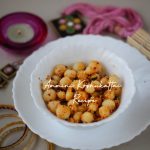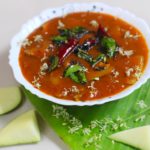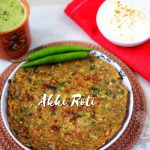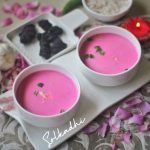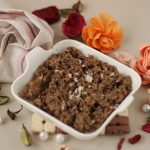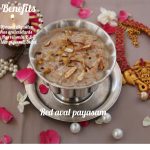Whip up a pachadi and incorporate the unique flavor of roasted urad dal and spices into your curd pachadi and make it exotic by tempering with spicy condiments and relish it with rice or idli dosa.
Index:
A Quick Skim Through These Topics May Enchant You With Interesting Information:
1. Tanjore Special Dangar Pachadi
2. An Introduction On Dangar Pachadi
3. The Origin And History Of Dangar Pachadi
4. The Exclusive Nature Of Dangar Pachadi
5. A Sneak peek Into Tanjore Cuisine
6. The Significance Of Pachadis In Thanjavur Cuisine
7. Needed Ingredients To Make Dangar Pachadi
8. Step Wise Directions To Make Authentic Thanjavur Dangar Pachadi
9. Points To Ponder
10. Faqs
11. Dangar Pachadi In A Nutshell
12. A Sample Thanjavur Thali With Dangar Pachadi
13. Historic And Cultural Significance Of Tanjore Cuisine
14. Takeaway
15. Nutritional Value
Dangar pachadi, a simple yet true gem in the treasure trove of South Indian cuisine, is a culinary delight that deserves every accolade it receives. This delectable dip, with its rich, complex flavors and enticing aroma, exemplifies the essence of traditional South Indian cooking. From its nutty and earthy undertones to the fiery kick of dried red chilies, dangar pachadi is a celebration of taste that leaves an indelible impression on every palate it graces.
An Introduction On Dangar Pachadi:
Dangar pachadi, also known as "Dangar chutney" or "Urad Dal Chutney," is a popular South Indian condiment that hails from the state of Tamil Nadu, specifically the Tanjore district. This flavorful chutney is a beloved accompaniment in South Indian cuisine, known for its robust and spicy flavor profile. The primary ingredients of dangar pachadi include roasted urad dal (black gram dal), cumin, curd, dried red chilies, tamarind, and a touch of conventional seasoning. This lost recipe from the treasure trove of Tanjore cuisine is sure to tickle your palates and your curiosity as well.
Dangar pachadi is characterized by its rich, nutty taste, with a subtle tanginess from the tamarind and a pleasant heat from the red chilies. It is traditionally prepared by dry-roasting the dals and chilies before grinding them with fresh coconut and tamarind. The resulting mixture is then tempered with mustard seeds, urad dal, asafoetida, and curry leaves, which enhances its flavor and aroma.
This versatile condiment can be served alongside various South Indian dishes, such as dosa, idli, vada, or even as a side dish for steamed rice. Dangar pachadi adds a delightful crunch and spiciness to meals, making it a favorite choice for those who enjoy the vibrant and diverse flavors of South Indian cuisine. Whether as a dip, spread, or chutney, dangar pachadi is a delicious and essential component of South Indian culinary traditions.
The Origin And History Of Dangar Pachadai:
History takes us way back to the maratha reign in Tanjore district (1674 -1818) if we take a sneak peek into the culinary journey of Tanjorean cuisine. Much interestingly, Tanjore cuisine had a remarkable Marathi influence owing to its tremendous rulers and their supreme reign. Researches show that the Tanjore Marathi cooks who worked in the royal palaces for the maharajas invented several dishes, as adaptions and modifications are the basic culinary art of Tanjore cuisine. One such creation is this "Dangar Pachadi" also called as "Dangarma" pachadi, a proud invention of the Tanjore Marathis from the imperial kitchen which has withstood the test of time and has traversed a long culinary journey till now.
"Dangar" is a Marathi word which means" papad making flour" which refers to urad dal and "dangarma" is a colloquial version of "dangarmaavu" which means the "flour which is used to make dangar pachadi". And both the terms have been used by the Marathi people and Tamil people as well which refers to the same. This delicacy Dangar Pachadi is usually served with traditional south Indian Thali with rice, sambhar, rasam, koottu, poriyal, appalam and curd.
The Exclusive Nature Of Dangar Pachadi:- "Less Is More"
This Dangar Pachadi's humble yet healthy ingredients come together in perfect harmony, creating a symphony of flavors that dances on your taste buds. The roasted urad dal and cumin provide a satisfying crunch, while the fresh curd adds a creamy, topical sweetness. Tamarind lends a subtle tangy note, and the artful tempering of mustard seeds, urad dal, asafoetida, and curry leaves enhances the chutney to a level of gastronomic excellence.
Whether served as a side dish, dip, or accompaniment, dangar pachadi elevates any meal it accompanies. Its versatility knows no bounds, adding a burst of flavor to dosa, idli, vada, bajji, bonda, kuzhi paniyaram, medu pakoda, pattinam pakoda or simply a bowl of steamed rice. Dangar pachadi is not merely a condiment; it is a testament to the rich culinary heritage of South India, a harmonious blend of tradition and taste that captivates food enthusiasts across the globe.
In every spoonful of dangar pachadi, you savor the centuries-old wisdom of South Indian cooking from the glorious Tanjore cuisine, a heritage passed down through generations, and an embodiment of culinary artistry at its finest. It is with great reverence that we explore the extraordinary world of Tanjorean recipes from the imperial kitchen including this dangar pachadi, a beloved treasure of South Indian cuisine that continues to delight and inspire palates far and wide.
A Sneak peek Into Tanjore Cuisine:
Tanjore cuisine, also known as Thanjavur cuisine, is a culinary tradition that originates from the historic city of Thanjavur, located in the Tamil Nadu state of South India. Renowned for its rich cultural heritage, Tanjore boasts of a culinary legacy that reflects the region's vibrant gastronomic history and diverse influences and adaptations from various cuisines. Tanjore cuisine is a delightful tapestry of flavors, textures, and techniques, deeply rooted in tradition yet open to innovation, that have been tried and tested in the palaces of maharajas and emperors.
At its core, Tanjore cuisine celebrates the essence of South Indian cooking, characterized by the abundant use of rice, lentils, coconut, and a plethora of spices. However, what sets Tanjore cuisine apart is its meticulous attention to every minute detail at each and every step, and a unique balance of flavors that create an unforgettable dining experience.
One of the hallmarks of Tanjore cuisine is its use of traditional cooking methods, such as slow-cooking in clay pots and grinding spices and pastes manually using stone mortars and pestles. These methods enhance the depth and authenticity of the dishes. And surprisingly we can still see this practice of using "ammikal and aatukaal" in many of the tanjore households.
Tanjore cuisine is also known for its distinctive vegetarian and non-vegetarian offerings. Vegetarian dishes often feature an array of rice-based delicacies, including aromatic biryanis, flavorful pulao, and comforting variety rice preparations with kuzhambu, kootu, rasam, poriyal, pachadi and thuvayal. In contrast, non-vegetarian dishes showcase a spectrum of curries and gravies which may include a lavish usage of fresh coconut, skillfully crafted with an assortment of meats, poultry, and seafood.
The region's proximity to the coastline infuses Tanjore cuisine with an abundance of seafood, adding a unique dimension to the culinary landscape. Dishes like Tanjore traditional crab curry and Meen Kuzhambu (fish curry) highlight the coastal influence.
Furthermore, the generous use of spices, such as black pepper, red chilies, and aromatic herbs like fennel, cumin, bay leaf, cinnamon, cardamom, khus khus, coriander and clove contribute to the robust and tantalizing flavors of Tanjore cuisine. The result is a symphony of taste that ranges from mildly spiced to fiery hot, catering to a diverse range of palates.
Intricately tied to the region's festivals, rituals, and celebrations, Tanjore cuisine has deep cultural significance. It is an integral part of weddings, religious ceremonies, and other cultural festivals and special occasions, where elaborate feasts are prepared to symbolize the richness of age old Thanjavur tradition and the joy of community.
In summary, Tanjore cuisine is a testament to the culinary artistry of South India, celebrated for its flavorsome dishes, time-honored techniques and culinary skills and its role in preserving the cultural heritage of the region. It invites all who savor its offerings to embark on a gastronomic journey through the heart of Tamil Nadu, where every bite tells a story of tradition, heritage, and the vibrant flavors of Tanjore.
The Significance Of Pachadis In Thanjavur Cuisine:
Pachadis, also known as dips or relishes which have a semi solid consistency basically, hold significant importance in Thanjavur cuisine and South Indian cuisine as a whole. These condiments play a crucial role in enhancing the overall dining experience and are cherished for several reasons:
Flavor Enhancement: Pachadis are revered for their ability to elevate the flavors of a meal. They provide contrasting tastes, textures, and aromas that complement the main dishes. Whether it's the fiery kick of a spicy pachadi or the cooling effect of a coconut-based one, these accompaniments add depth and dimension to the meal.
Digestive Benefits: Many pachadis contain ingredients like tamarind, ginger, and spices like green chili or pepper which are known for their digestive properties. Consuming pachadis can aid in digestion, making them a soothing addition to a meal, especially when indulging in rich and heavy dishes.
Balancing Act: Thanjavur cuisine often includes a variety of dishes with diverse flavors and spice levels. Pachadis serve as a balance, helping to moderate the spiciness or richness of other dishes. They allow diners to customize their meals to suit their individual preferences.
Nutritional Value: Pachadis are not only flavorful but also nutritious. Ingredients like coconut, lentils, and various vegetables used in pachadis provide essential vitamins, minerals, and dietary fiber. This adds a healthy component to the meal.
Taste Exploration: Pachadis offer a platform for culinary experimentation. Cooks can create a multitude of flavors by combining different ingredients, ensuring that no two pachadis are exactly alike. This diversity keeps the cuisine exciting and continually evolving.
Cultural and Regional Significance: Pachadis are deeply ingrained in the cultural and culinary traditions of Thanjavur and South India. They are an integral part of festive feasts, religious rituals, and special occasions. Each region and household may have its unique pachadi recipes, which are passed down through generations, preserving the culinary heritage.
Versatility: Pachadis are incredibly versatile and can be adapted to suit the availability of seasonal ingredients. They can be prepared with a wide range of vegetables, fruits, herbs, and spices, allowing for creativity and variety in the cuisine.
In summary, pachadis are not just condiments in Thanjavur cuisine but an essential part of the gastronomic experience. They add depth, balance, and nutritional value to meals while preserving cultural traditions and allowing for culinary creativity. Whether enjoyed with rice, dosa, idli, or other South Indian dishes, pachadis are an indispensable component of the region's rich and flavorful cuisine.
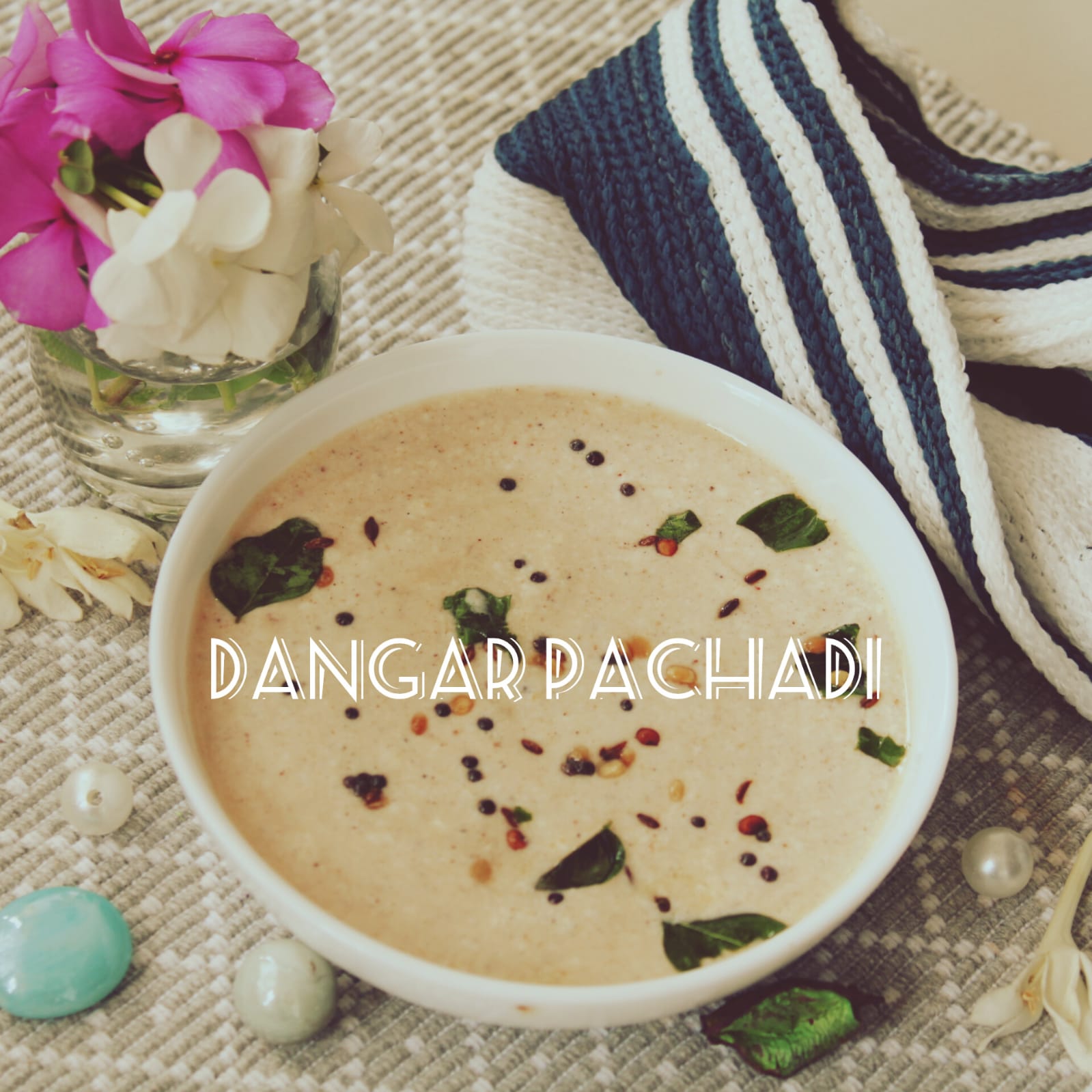
Needed Ingredients To Make Dangar Pachadi:
Urad Dal (Black Gram Dal): Urad dal is a type of split black gram lentil used in dangar pachadi. It adds a nutty flavor and a creamy texture to the condiment.
Cumin seeds: Cumin seeds is roasted to a golden brown before being blended into dangar pachadi, providing a crunchy element and a slightly sweet taste.
Curd: Fresh homemade curd is a key ingredient, imparting a creamy and tropical sweetness to the chutney while balancing the heat of spices.
Dried Red Chilies: Dried red chilies are roasted to enhance their flavor and spiciness, giving dangar pachadi its characteristic heat.
Asafoetida: A small amount of asafoetida solid is added to provide a subtle tangy note, balancing the flavors and enhancing the overall taste.
Salt: Salt is used to season the pachadi, enhancing the flavors and bringing out the natural tastes of the other ingredients.
Oil (for Tempering): Typically, coconut oil is used for tempering, which not only adds a unique flavor but also complements the coconut-based chutney. It's infused with mustard seeds, urad dal, asafoetida, and curry leaves to create a flavorful topping.
- Mustard Seeds: It is the chief tempering agent in any south Indian dish especially the pachadis like dangar
9. Curry Leaves: The best aromatic herb used to spruce up any dish and gives a great appeal.
These ingredients come together harmoniously to create the distinct and delicious flavor profile of dangar pachadi, a beloved South Indian condiment.
Step Wise Directions To Make Authentic Thanjavur Dangar Pachadi:
Heat a tawa and tip in one or two dried red chilies and add two teaspoons of urad dal to it. Roast in low flame until it turns light brown.
Throw in some cumin seeds along with two tiny bits of asafoetida. Stir in altogether until fragrant. turn off the flame and let it cool for a while. Blend it altogether into a coarse powder along with the required amount of salt.
Heat the saucepan again and tip in a teaspoon of coconut oil. When it heats up, just scatter some mustard seeds along with some cumin. Also throw in some urad dal and curry leaves. When the curry leaves splutter, just turn off the heat.
Take a bowl and plop in a cup of curd to it. Add two tablespoons of the urad dal spice powder and drop in the tempered ingredients to it. Stir in altogether and sprinkle some lush green coriander leaves and serve with rice, kootu and Rasam.
Points To Ponder:
Roasting Dals: Ensure that you roast the urad dal until it turns a uniform golden brown color. This step is crucial as it enhances the flavor of the lentils and gives the pachadi a nice crunch.
Use Fresh Ingredients: Whenever possible, use fresh ingredients, especially grated coconut. Fresh coconut adds a creamy texture and a delightful tropical sweetness to the pachadi.
Adjust Spice Level: Control the spiciness by varying the number of dried red chilies you use. Remember that dried red chilies can vary in heat, so adjust to your preferred spice level.
Tangy Balance: Be specific about the tanginess of the curd. Let the curd be fresh enough to provide a gentle tangy flavor without overpowering the other ingredients.
Tempering Technique: When tempering with mustard seeds, urad dal, asafoetida, and curry leaves, ensure that the mustard seeds splutter and the urad dal turns golden brown. This step adds a flavorful topping to the pachadi.
Texture Control: Grind the ingredients into a slightly coarse paste for a traditional dangar pachadi texture. Avoid making it too smooth.
Consistency Adjustments: If the pachadi is too thick, you can add a little water or yogurt to achieve the desired consistency. Conversely, if it's too thin, add more grated coconut or roasted dal.
Seasoning Timing: Add salt and tamarind at the beginning of grinding to ensure even distribution of flavors throughout the pachadi.
- Serve at the Right Temperature: Dangar pachadi is often served at room temperature or slightly chilled. Allow it to sit for a while after preparation before serving to let the flavors meld.
Storage: Store dangar pachadi in an airtight container in the refrigerator. It tends to taste better as it sits and allows the flavors to meld, making it a great make-ahead condiment.
Faqs:
What is Dangar Pachadi?
- Dangar pachadi is a traditional South Indian condiment or chutney made from roasted lentils, coconut, dried red chilies, tamarind, and spices. It is known for its nutty, spicy, and tangy flavor.
What does "Dangar" mean?
- "Dangar" refers to the primary ingredient in this chutney, which is roasted urad dal (black gram dal).
What are the key ingredients of Dangar Pachadi?
- The main ingredients of dangar pachadi include urad dal, cumin seeds, curd and red chilies. It is also tempered with mustard seeds, urad dal, asafoetida, and curry leaves.
How is Dangar Pachadi typically served?
- Dangar pachadi is commonly served as a side dish or condiment with South Indian dishes like dosa, idli, vada, and rice. It adds a burst of flavor and spice to these meals.
Can I adjust the spice level of Dangar Pachadi?
- Yes, you can adjust the spice level by varying the number of dried red chilies you use. Adding more chilies makes it spicier, while reducing them makes it milder.
Is Dangar Pachadi vegan?
- Yes, dangar pachadi is typically vegan as it doesn't contain any animal-derived ingredients. It's made using plant-based ingredients like lentils, coconut, and spices.
Can I store Dangar Pachadi?
- Yes, dangar pachadi can be stored in an airtight container in the refrigerator for a few days. It tends to taste better as it sits, allowing the flavors to meld.
Can I customize Dangar Pachadi with additional ingredients?
Absolutely! While the traditional recipe follows a specific set of ingredients, you can experiment by adding ingredients like fresh coriander leaves, garlic, or roasted cumin seeds to customize the flavor to your liking.
Dangar Pachadi In A Nutshell:
- Nature: Condiment
- Color: Light Brownish
- Texture: Slightly Coarse
- Consistency: Chunky
- Flavor: Spicy-Tangy
- Smell: Aromatic
- Taste: Savory-Spicy
A Sample Thanjavur Thali With Dangar Pachadi:
Thanjavur Thali, also known as a South Indian meal platter, typically includes a variety of dishes to create a balanced and flavorful dining experience. Here's a sample Thanjavur Meal that incorporates dangar pachadi:
Main Dishes:
Steamed Rice: A generous portion of fragrant, fluffy white rice, which serves as the staple base for the meal.
Sambar: A tangy and spicy lentil-based soup with vegetables, tamarind, and a unique blend of spices.
Rasam: A light, peppery soup made with tamarind and tomato, seasoned with mustard seeds, curry leaves, and asafoetida.
Tamarind Rice (Puliyodarai): Tangy and spicy rice cooked with tamarind paste, jaggery, and an aromatic mix of spices, giving it a unique sweet-and-sour flavor.
Accompaniments:
Dangar Pachadi: A chunky and spicy urad dal and coconut chutney, adding a nutty and fiery kick to the meal.
Cabbage Poriyal: A dry sautéed cabbage dish with mustard seeds, curry leaves, and grated coconut.
Potato Curry: A mildly spiced potato curry with a hint of turmeric, red chili powder and cumin.
Curd (Yogurt): Plain yogurt served as a cooling element to balance the spiciness of the other dishes.
9. Papad: Crispy appalam or papadum, typically deep-fried or roasted, providing a crunchy element to the meal.
10. Pickles: A small serving of spicy pickle, often made with mango, lime or wild lemon ( kidarangai in tamil) for an extra burst of flavor.
11. Sweet Pongal (Sakkarai Pongal): A delectable dessert made from rice, lentils, jaggery, and ghee with cashews.
12. Buttermilk: A refreshing yogurt-based drink, often tempered with curry leaves, mustard seeds, and asafoetida.
This Thanjavur Thali showcases a variety of flavors and textures, from the spicy and tangy dishes to the cooling yogurt and delightful dessert. Dangar pachadi adds a unique spicy element to the ensemble, making it a well-rounded and satisfying South Indian meal.
Historic And Cultural Significance Of Tanjore Cuisine:
Dangar Pachadi - A Preview
Ancient Culinary Traditions: South Indian cuisine, including the use of lentils, coconut, and spices, has ancient roots dating back thousands of years. Lentils, in particular, have been a staple source of protein for generations.
Simple Ingredients: Dangar pachadi's primary ingredients, urad dal and coconut, have been readily available and commonly used in South Indian households for centuries. These ingredients were known for their nutritional value and versatility.
Flavor Enhancements: Dangar pachadi, with its spicy and tangy flavors, likely served as a condiment to add a burst of taste to the simple rice-based meals that were common in South India. The spiciness and tanginess would have been appreciated for their ability to make meals more interesting.
Cultural Significance: South Indian cuisine, including the preparation of chutneys and condiments, has strong ties to cultural and religious practices. Dangar pachadi, along with other dishes, may have been part of offerings in temples and rituals, symbolizing the richness of tradition and heritage.
Community Gatherings: In the early centuries, communal dining was common in South Indian communities. Families and communities would come together for feasts during festivals and special occasions. Dangar pachadi, with its spicy and flavorful profile, would have been a part of these festive spreads.
Preservation of Culinary Heritage: Recipes and culinary traditions were often passed down orally from one generation to the next. The art of making dangar pachadi, like other traditional dishes, would have been preserved and cherished by families, ensuring that the flavors and techniques endured through time.
In essence, dangar pachadi, with its blend of roasted lentils, coconut, and spices, likely played a role in enhancing the culinary experiences of our ancestors in South India. It added depth and flavor to their meals, served as part of their cultural and religious practices, and contributed to the enduring culinary heritage of the region. While the specific historical details may remain elusive, the flavors and traditions associated with dangar pachadi continue to be celebrated in South Indian cuisine today.
Takeaway:
In the realm of South Indian cuisine, dangar pachadi stands as a testament to the exquisite artistry of flavors and the richness of tradition. Its fiery spiciness, nutty depth, and subtle tanginess make it a culinary gem that has graced the plates of generations. With each slurp, we savor the centuries-old wisdom of South Indian cooking, a heritage of flavors passed down through time.
Dangar pachadi is more than just a condiment; it is a vibrant mosaic of history, culture, and culinary excellence that tantalizes the taste buds and nourishes the soul. As we partake in its soulful embrace, let us honor and celebrate the enduring legacy of this beloved South Indian treasure.
Happy Cooking !
Ingredients
Directions
Heat a tawa and tip in one or two dried red chilies and add two teaspoons of urad dal to it. Roast in low flame until it turns light brown.
Throw in some cumin seeds along with two tiny bits of asafoetida. Stir in altogether until fragrant. turn off the flame and let it cool for a while. Blend it altogether into a coarse powder along with the required amount of salt.
Heat the saucepan again and tip in a teaspoon of coconut oil. When it heats up, just scatter some mustard seeds along with some cumin. Also throw in some urad dal and curry leaves. When the curry leaves splutter, just turn off the heat.
Take a bowl and plop in a cup of curd to it. Add two tablespoons of the urad dal spice powder and drop in the tempered ingredients to it. Stir in altogether and sprinkle some lush green coriander leaves and serve with rice, kootu and Rasam.

